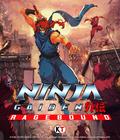Buy Bloodstained: Ritual of the Night
While certainly not the only one responsible for it, Koji Igarashi worked on Castlevania: Symphony of the Night to Castlevania: Order of Ecclesia until the franchise was rebooted by Mercury Steam. Those titles are widely considered to be some of the best games ever made, and the genre has seen plenty of indie takes, but nothing was quite Castlevania — until Igarashi's Bloodstained: Ritual of the Night became one of the most successful Kickstarter campaigns ever. The good news is that Bloodstained avoids pretty much every pitfall that other Kickstarter "spiritual successors" experienced. It has its flaws, but by and large, it provided exactly what people wanted: a return to the "Igavania" style.
Bloodstained is set in a gothic European setting, where alchemists and monsters are common. A group of alchemists who are worried about the industrial revolution have summoned forth an army of demons to force the world to bow to their whims. They were eventually beaten at great cost. Among the two survivors were Miriam and Gebel, two "shardbinders" with the power to use demonic magic. For unknown reasons, Miriam fell into an enchanted sleep and awoke only when the dark castle used by the alchemists mysteriously began spewing demons again — seemingly headed by her lost friend, Gebel. Miriam sets out to use her powers to stop Gebel and find the demonic source.
Bloodstained is a Castlevania game through and through. If you played Symphony of the Night and its handheld descendants, you'll see a lot that's familiar here. It's pretty much what you'd get if you threw all the Igavanias into a blender. Miriam is like a mix of Soma Cruz and Shanoa, gathering new powers and using magic to blast her foes. Exploration has a lot more in common with Symphony of the Night; there are lots of new areas to explore, creatures to find, and tons of weird things to discover. Even the core gameplay is pure Castlevania, down to destroying candles to collect power-ups (roses, in this case) that refill your MP so you can use more special attacks.
Bloodstained offers a lot of ways to power up. Like Soma Cruz in Aria of Sorrow, Miriam can collect shards from defeated enemies. Each shard can either be an attack, an activated power, a passive buff or a familiar. A shard is a useful tool, but you can further power up each shard, and each shard has a rank and a grade. The grade increases as you collect additional copies of that shard and power it up. The rank is increased by upgrading shards at an alchemist to increase a property, such as its size. A rank 9, grade 9 shard is an absolutely devastating beast, and since every shard can be powered up, it's possible to turn pretty much any attack into a powerful one. Additionally, mastering any passive shard grants its effect permanently to offer a constant boost of power. There are also gray shards that grant movement abilities that can also be upgraded, such as double-jump and underwater swimming.
You upgrade your shard with alchemy, which also can be used to craft new armor and weapons with materials found in the castle. Bloodstained has an absolutely fantastic selection of weapons ranging from swords and boots to firearms and, of course, whips. Most weapons have a distinct attribute, even if it's in the form of techniques, which are special abilities that are carried out via fighting game-style button combinations.
There are a ton of accessories in the game, with some offering passive buffs or changing the way certain attacks work. More importantly, every helmet and every accessory looks different, which allows you to customize Miriam to your liking. You can also visit Todd the Evil Barber, who can change Miriam's hair and outfit/skin colors. Unfortunately, the accessory's appearance is tied to attributes, so you can't fully customize Miriam without sacrificing stats. The game is easy enough that it isn't a huge concern, though.
Bloodstained feels good because you're always finding something new, whether it's a power, an ingredient for a craft, or a weapon. There's a small village on the outskirts of the castle that has a series of side-quests where you do everything from cooking food for an old woman to killing monsters. Any random wall can hide a new area, power, or weapon. There's something around every corner, and it's only at the very end of the game that it starts to feel a little thin. There's certainly enough here to keep you busy for the entire playthrough.
What is likely to make or break Bloodstained for a player is that it adheres mostly deeply to the "if everything is broken, then nothing is" style of balance. As in other Igavanias, it's easy to become extremely powerful. On the Normal difficulty, you'll quickly become a buzz-saw that tears through large swarms of foes. The game has enough options that it's fun to be powerful. It doesn't matter if you want to shoot giant beams of laser energy; beat up enemies with floating portraits; or be a knife-throwing, kung-fu bunny girl — your options feel strong and worthwhile. There are some weak points, such as guns that don't become absurdly powerful until late in the game, but they are few and far between.
Bloodstained has a few cases of genuinely bad progression, where it's easy for a player to get lost through no fault of their own. The most egregious example involves learning the swimming ability, which is a random drop from a jellyfish enemy that you have no reason to assume drops a plot-critical shard. There are only a few of these moments, but they stand out because they're so random, when every other necessary item to progress is clearly signposted behind a boss or cut scene. It isn't as bad once you know what to look for, but I can imagine quite a few people getting stuck and not being able to proceed for an hour or two.
Bloodstained has a fairly good amount of replay value. A single playthrough probably takes about 10 hours, and there are two more difficulty modes and a series of optional bosses — including one DLC boss who was originally a Kickstarter backer exclusive. There are also a lot of bonus modes coming down the line thanks to the Kickstarter, including two additional playable characters, a roguelike mode, a classic mode that converts the gameplay into a traditional level-based platformer, and so on. It's a fully featured game on its own, but like fellow Kickstarter success story Shovel Knight, it's going to shine even more once everything's out.
Bloodstained looks nice, but it clearly shows its budget in places. The character models are nice but a little stiff, and while the castle and the enemies are generally pretty cool, there are a lot of areas that feel half-baked. One of the last areas in the game involves traveling through a giant version of an old area that feels more recycled than cool. There's also some noticeable slowdown, which is surprising for a game that isn't exactly graphically intensive. The music is quite good, with a lot of obvious Castlevania-inspired tracks and themes. The voice acting is solid for the most part, but a lot of it involves nostalgia, including the casting of David "Solid Snake" Hayter as Zangetsu and Robert Belgrade, the original voice of Alucard, as the vampire O.D.
All in all, Bloodstained: Ritual of the Night is exactly what it was marketed as: the revival of the Igarashi Castlevania games. It might not have Konami's IP, but it has the feel, the gameplay, and the style that no other game has quite been able to replicate. You'll love it if you're a fan of the franchise, and it's a great place to start if you're a newcomer. Some annoying design decisions and general performance issues hold it back. In the end, morning has come to vanquish the terrible night, and Bloodstained is hopefully the start of a new generation of Igavania.
Score: 8.5/10
More articles about Bloodstained: Ritual of the Night











 Bloodstained: Ritual of the Night is a gothic, exploration-focused action platformer, designed by Koji Igarashi, known for his work on Castlevania: Symphony of the Night.
Bloodstained: Ritual of the Night is a gothic, exploration-focused action platformer, designed by Koji Igarashi, known for his work on Castlevania: Symphony of the Night.











































